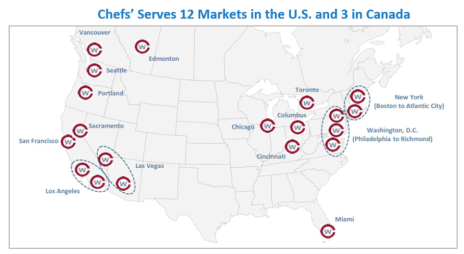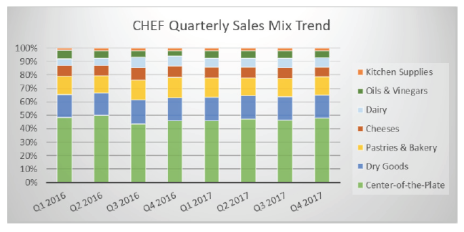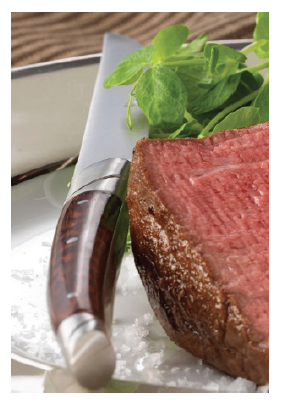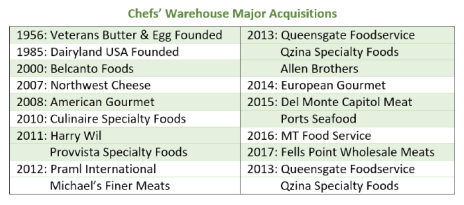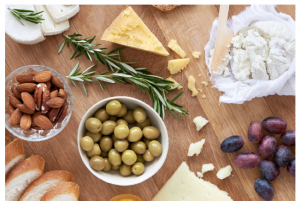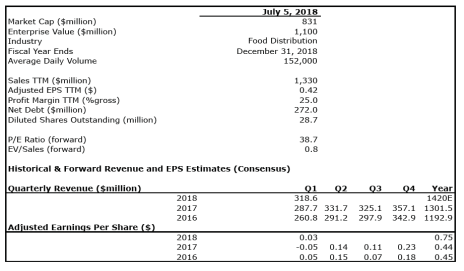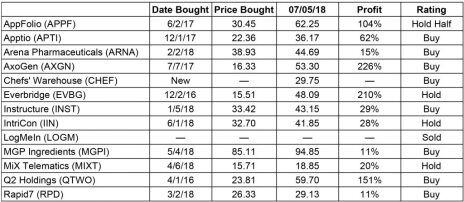With this month’s new addition, I decided to go in a different direction then we have with previous recommendations. Instead of featuring another rapid-growth medical device or software stock, I’ve selected a consumer defensive stock in a very specialized industry and with a more modest growth profile. It’s the perfect summertime stock for a period in which many growth stocks are acting a little schizophrenic—especially for those investors who like getting out of the house for a bite to eat and a good beer or glass of wine.
Cabot Small Cap Confidential 230
[premium_html_toc post_id="153045"]
THE BIG IDEA
The year was 1956. Peter Pappas, originally from Cyprus, had recently returned to New York City after fighting in the Korean War. Sensing a need for food deliveries to local restaurants, Mr. Pappas teamed up with his cousin and founded the Veterans’ Butter and Egg Company. The duo operated out of a small warehouse on Greenwich Street, selling butter, cheese and eggs to restaurants around the city.
It was a family business in which the kids usually lent a hand. Those experiences gave Peter’s two sons, Christopher and John, a foundation of knowledge from which they would pull when they took over the business in 1985.
One of the first things they did was broaden the scope of services and rename the company Dairyland USA. Their vision was to turn Dairyland USA into a distinguished supplier of specialty ingredients to independent restaurants, hotels and country clubs in major markets across the U.S.
The restaurant supply business was not an easy one to be in. The restaurant industry is fickle and challenging. But despite the odds, there are hundreds of thousands of independent restaurants that do succeed. And over the decades the brothers figured out how to consistently operate in the black serving these successful proprietors.
Today, the high-end, slightly larger independent restaurants are where the action is.
The best places have customers that come back again and again and again, particularly in the top 20 or so metropolitan markets – places like New York City, Chicago, Boston, San Francisco, Napa Valley, Los Angeles, Miami and Vancouver, Canada.
These restaurants, the ones that have broken through barriers to become large enough to order from broadline foodservice distributors, are killing it.
This may be because more people are flooding into urban areas where independent restaurant density is higher. Or because a good economy has people eating out more. Or because celebrity chefs with amazing menus are just too compelling to pass up. Or because Boomers, Gen Xers and Millennials all want to get out of the house and avoid cooking!
Whatever the reasons, most people agree that a good meal served at the right time, and in the right atmosphere, with a good drink, is a nice way to spend time and money. And demographic trends, restaurant reviews and industry analysts all point toward faster growth in independents than national chains.
The bottom line is that independent restaurant growth is expected to be around 4% to 5% annually through 2020. That’s roughly twice the pace of expected growth from chains.
The data from broadline food distributors illustrates the trend. Sysco (SYY), U.S. Food Holdings (USFD), and Performance Food Group (PFGC), the three largest broadline food distributors out there (which together represent about 30% of the industry) all reported that case growth from independents was above total case growth.
In other words, independent restaurants in key markets are in the sweet spot.
Which brings us back to Peter and Christopher Pappas.
These two brothers are still running their business. John is Operations Manager and Chris is the Chairman and CEO. But Dairyland USA has evolved a lot over the last 30 years! The company has been making prudent acquisitions to build out distribution in key markets, strategic investments in technology to help with ordering and tracking, and supply chain and warehouse efficiency improvements to keep costs low.
The company now generates well over a billion dollars in annual sales and is publicly-traded with a market cap of $830 million. The culture that helped the company get off the ground appears to be intact, and the stock is doing great. Future growth in revenue and EPS looks good too.
THE COMPANY/PRODUCT
The Chefs’ Warehouse (CHEF) is a specialty food distributor that has been supplying artisan and high-quality food products to chefs across the U.S. for over three decades. Since opening its doors as Dairyland USA in 1985, the company has been committed to culinary excellence, customer service and product knowledge. Today, Chefs’ stated goal is to support the needs of all its chefs through distinctive and hard-to-find specialty and center-of-the-plate food products. The company is based in Ridgefield, CT.
Its primary focus is on menu-driven, family-owned and independent restaurants, of which there are around 350,000 across the U.S. The company serves over 30,000 of these customers across 12 key markets, plus three additional markets in Canada (see map).
CEO John Pappas says independent restaurants make up around 54% of the $262 billion U.S. foodservice distribution industry. Around 80% of Chefs’ customers are independents with five units or less, while the remaining 20% are slightly larger operators, but none has over 55 units.
He believes Chefs’ serves the top 10% to 20% of earners in the world. Many customers are upscale casual and fine dining locations in tourist destinations, such as the Four Seasons, Ritz Carlton and White Elephant. This customer base has helped Chefs’ do well in good times and maintain resiliency during recessions.
With 2017 revenue of $1.3 billion, the takeaway message is that, even though Chefs’ is the leading national specialty supplier in the highly fragmented independent restaurant market (where there are over 15,000 distributors), it still holds less than 5% share in its target market. That means plenty more room for growth if management keeps making the right moves.
Diverse Product Offerings Keep Chefs Coming Back
One of the right moves Chefs’ Warehouse has made for decades is focusing on a large and differentiated product offering. The company stocks over 48,000 items, ranging from broadline food products, such as cooking oils, butter, eggs and milk, to distinctive and hard-to-find specialty food products, including cheeses, unique oils and vinegars, truffles, and charcuterie, to center-of-the plate proteins like custom cut beef, hormone-free chicken and fresh seafood. If a customer asks for something that Chefs’ doesn’t carry, it will do its best to find it.
Chefs’ wide variety of food products, sourced from 2,500 different suppliers throughout North America, Europe, Asia and South America, has helped the company develop a loyal following from the finest independent restaurants, hotels, country clubs, caterers, bakeries, cruise lines, casinos, chocolatiers and gourmet stores in major metropolitan areas across the U.S. and Canada.
Customers keep coming back and expanding their purchasing volume because Chefs’ Warehouse helps them offer diners unique menus, and get their cooking staples, all from one supplier.
While there is some variability quarter to quarter, Chefs’ typically derives over three-quarters of revenue from center-of-the plate proteins (47% of revenue), dry goods (17% of revenue) and pastries & bakery products (14% of revenue). Cheeses, dairy, oils and vinegars and kitchen supplies each generate 1.5% to 8% of revenue, on average.
Chefs’ is a Difficult Business to Emulate
As a publicly traded entity with a market cap of over $800 million, Chefs’ Warehouse has scale on its size. It is geographically diversified and operates 25 distribution centers. It delivers six days a week in many areas, and many orders are taken past the cutoff window of its competitors.
Investments in infrastructure and supply chain efficiencies have helped the company ensure only the freshest product arrives at customers’ doors, usually within 12 to 24 hours of order placement. That means customers get what they need, when they want it. Last year, 97% of in-stock items ordered were delivered by the requested date.
That customer focus has paid off. Among publicly traded peers, Chefs’ has, by far, the plumpest gross profit margins.
This isn’t a business for the faint of heart. Management is candid that it is a complex, dynamic and often difficult business! It’s constantly evolving as food and taste trends change. Given that the company sources product from around the world, there are always product availability, supply chain and other logistical challenges to overcome.
Moreover, personal relationships and reputation are key differentiators in the restaurant industry, especially when top chefs are concerned. Chefs’ Warehouse is ingrained in the industry, having served both The Culinary Institute of America and The French Culinary Institute for nearly a decade. Many future great chefs are introduced to the company while attending these schools.
The compelling thing for investors is that Chefs’ likes these challenges and has figured out ways to make them work to its advantage. The company has enviable margins, but there still isn’t a lot of meat on the bone here. That’s why Chefs’ has invested in technology to make operations flow as efficiently as possible.
Pick-to-voice technology helps warehouse employees fill orders quickly. GPS and vehicle monitoring technology permits proactive fleet maintenance and ensures on-time delivery. Most trucks have multiple, temperature-controlled compartments so different products will arrive at the best temperature.
In short, Chefs’ business model is very difficult to emulate, which is one reason the company doesn’t face as much direct competition in the independent restaurant market as players in the chain restaurant market do.
10 Core Companies Means Something for Everyone
Chefs’ Warehouse currently has 10 core companies. Here are a few details on each of them:
The Chefs’ Warehouse is the flagship brand distributing specialty foods into major culinary markets across the U.S. Products range from specialty olive oils to dairy products, and are sourced from both small producers and large, nationally recognized manufacturers.
Dairyland USA was the company’s first brand in the Hunts Point section of the Bronx, where it has been distributing ingredients to Manhattan and surrounding areas, six-days-a-week, for over 30 years.
For almost 60 years, Michael’s has been serving steakhouses across Ohio and the Midwest with center-of-the-plate, seafood and specialty food items. The Columbus-based distributor’s protein products can also be purchased by consumers for cooking at home, or by corporations to send as gift boxes to clients.
Allen Brothers specializes in distributing the finest prime meats, veal, lamb, pork and seafood to top chefs and restaurants across the country. The steak specialist is based in Chicago and has been in business since 1893.
Bel Canto Foods is the importing arm of The Chefs’ Warehouse. With long-running relationships across Europe, Asia and South America, Bel Canto is responsible for a steady supply of quality imported products.
Qzina specializes in chocolates and pastries. For the last 30 years it has been supplying products and services to bakeries, hotels, caterers, restaurants and commercial customers from strategically located U.S. and Canadian warehouses.
Portland, Oregon-based Provvista Specialty Foods grew from founder Joe Guth’s desire for more specialty foods when he was sous chef at Portland’s popular Zefiro restaurant. Provvista’s specialty offerings have expanded over the years and now include American artisanal products as well as imported goods.
Del Monte Meat Company was founded in San Francisco in 1926 and has grown into a leading provider of meats, game, seafood and poultry to the Bay area and beyond.
Ports Seafood is another San Francisco supplier, but with a singular focus on seafood. It was started by Timothy Ports in 1993 and has maintained an intense focus on properly handled seafood, delivered fresh from boat to door, ever since.
Fells Point Meats sprang up in the Broadway Market in Baltimore, Maryland in 1993. The company, led by two Dutch founders, has become well known beyond Baltimore’s historic Fells Point neighborhood for artisanal hand cut meats and top-notch customer service.
Expanding Organically, and Through Acquisitions
Acquisitions have become a larger part of the Chefs’ growth story over the last decade and have helped the company grow into its infrastructure, expand into new markets and increase operating efficiency. In 2014 an integration team was put together to help fold new acquisitions into the Chefs’ family and merge technology infrastructure to maximize synergies as quickly as possible.
In just the last six years, the company has completed eight acquisitions, ranging in cost from $400,000 to $124 million, for an upfront total cost of $253 million. These acquisitions have been paid for through a mixture of debt and equity offerings (2013 and 2017). And they are a big part of the reason revenues are up over 93% since 2013.
On the most recent conference call, management indicated that the prices for new acquisitions aren’t as attractive as they have been, so I don’t expect any major purchases in the near future. But don’t be surprised if you wake up tomorrow to hear that Chefs’ has made another modest sized, tuck-in acquisition.
E-Commerce Platform Adds Convenience & Boosts Efficiency
E-commerce has been relatively slow to come to the restaurant supply industry. But it’s catching on fast now and helping differentiate those players with powerful and user-friendly ordering and automation platforms. U.S. Foods is one broadline distributor that’s make tremendous progress. Chefs’ Warehouse is another.
Chefs’ website provides what you would expect—real-time inventory and pricing, guided search and navigation options and a mix of user-generated and automatic Favorites lists to help simplify ordering. An Artificial Intelligence (AI) backed merchandising solution launched late last year, as did a mobile app that included no-click checkout. Over time this platform should help drive more business per customer and help reduce Chefs’ sales and support costs. On the Q1 2018 conference call management said it is running roughly $2.2 million in revenue per week through the platform, and that around 12% of these orders came through the mobile app.
What’s Next?
Chefs’ is growing up. Yes, the company has been around for over 30 years and has been publicly traded for the last six. But it’s also been making a lot of big moves in recent years, from acquisitions and technology infrastructure spending to equipment and warehouses. As CEO John Pappas recently said, he can now “… finally see over the mountain.”
That means Chefs’ is growing into its infrastructure and now growing gross profit dollars faster than revenue. That translates into good things like cash flow growth, the financial strength to reduce debt, ability to expand into new markets and freedom to develop growth strategies from a position of strength.
The Business Model
Most of Chefs’ sales come through business-to-business (B2B) channels with independent restaurants and small chains. It also does a very small portion of direct-to-consumer (DTC) business as a result of the 2013 acquisition of Allen Brothers. The company relies on a sales force of around 470 people, as well as collaborative relationships with thousands of chefs, to help drive case growth. There is roughly one sales professional for every 64 customers. Many sales and customer service people have formal culinary training or degrees in the culinary arts, which helps them build rapport with customers’ chefs. The sales team also has advanced software that provides optimized pricing, so it has the flexibility to determine item pricing in real-time. Chefs’ has a diverse customer base; the top 10 customers made up less than 2% of total sales in 2017.
The Bottom Line
Chefs’ has been a relatively rapid grower in the foodservice distribution space. Over the last three years average revenue growth, including acquisitions, has been 16.2%. That’s the fastest in its peer group of publicly traded distributors, which includes US Foods, Sysco, Performance Food Group Company and United Natural Foods, Inc.
These companies have each posted three-year average revenue growth rates of 1.7%, 6.0%, 7.1% and 11.2%, respectively. As you can see in the accompanying chart, growth through acquisitions has been a big trend in the industry. Growth rates without these acquisitions (i.e. organic growth rates) would have been much lower for each company over the comparable three-year period.
Chefs’ total revenue growth is by far the fastest, averaging 16.2% over each of the last three years. Acquisitions have historically contributed a good portion of topline growth. However, in 2017 Chefs’ benefited from just one acquisition, Fells Point. As a result, revenue growth in 2017 was a relatively modest 9%. Adjusted earnings per share (EPS) was $0.44.
In the first quarter of 2018 (reported in early-May) Chefs’ reported revenue growth of 10.7% to $318.6 million and adjusted EPS of $0.03, an improvement from a loss of -$0.05 in the comparable quarter. Growth would have been a little higher if not for severe weather in California, the mid-Atlantic, and the Northeast. Growth in unique customers was 3.5%. Due to a debt refinancing in 2017 (Chefs’ carries $314 million in long-term debt) interest expense in the quarter dropped by $900,000, to $5 million. The company completed a secondary offering that raised $34 million in December 2017.
Management has issued guidance for 2018 that calls for revenue growth of around 9.2% to $1.42 billion and EPS growth of 55% to 75% ($0.68 to $0.77). This guidance is evidence that management sees Chefs’ growing into its infrastructure and that the profit and cash flow spigots are opening up.
RISK
Fragmented Industry: The food distribution industry is highly fragmented with a few large broadline suppliers and thousands of small, specialty suppliers. This means there is a lot of room for consolidation, which can be both good and bad, depending on how talented an acquiring company’s management team is.
Restaurant Industry is Fickle: Restaurants are notoriously challenging to operate, and their fortunes rise and fall depending on consumer spending habits. On the other hand, new restaurants are always opening up! Chefs’ caters to the higher-end spectrum of the industry, which tends to be relatively stable.
Rising Exposure to Protein Inflation: With the acquisitions of Michael’s, Allen Brothers, Del Monte and Fells Point, a larger portion of Chefs’ revenue comes from center-of-the-plate proteins, including meat, poultry and seafood. Prices for these proteins have been subject to inflation in recent quarters.
Potential Margin Impacts from Inflation: Chefs’ stated that internally reported inflation was 3.2% in 2017 and 1.2% in 2016. Recently, inflation in certain proteins (such as choice tenderloins) was especially high (in the neighborhood of 10% year-over-year). Some of these costs can be passed on, while some cannot.
Rising Freight Costs: This is just another input cost that fluctuates with the price of gasoline. When gas prices go up it’s more important than ever that Chefs’ operate an efficient supply chain and an efficient fleet to keep a lid on costs.
Weather-Related Disruptions: Weather regularly impacts the restaurant supply industry but sometimes storms are much more intense than normal. That was the case in the beginning of 2018, when Chefs’ management team estimated severe weather shaved about 1% off organic growth.
COMPETITION
The foodservice distribution industry is competitive. Price and the quality of the product delivered, as well as the distributor’s ability to completely and accurately fill orders, are the three main factors driving a buyer’s sourcing decisions. The most intense competition is with large hotels and caterers, where big contracts may be up for grabs and when distributors often market their services to a customer over a long period of time. Given Chefs’ primary focus on high-end independents, it typically competes with a large number of small, local distributors, as well as a few large foodservice distributors, including Sysco, US Foods, Performance Food Group Company and United Natural Foods, Inc. It doesn’t face a lot of competition from low cost suppliers, such as Wal-Mart (WMT), Costco (COST) and Restaurant Depot.
THE STOCK
Trading Volume: Chefs’ Warehouse has a market cap of $830 million and trades an average of 150,000 shares daily. That means roughly $4.3 million worth of stock trades each day. Our subscriber group shouldn’t move this stock. Heavy days are +300,000 shares, and that’s happened 12 days over the last six months.
Historical Price: The company went public in July 2011 at 15 and has had its ups and downs in the years since. A rally in 2013 carried shares up near 30, but that proved to be a multi-year top and from 2014 through 2017 CHEF retreated, ultimately trading below 12 before it found firm footing. The trend has been much more stable and positive over the last two years as CHEF has risen steadily back to its previous high. Over the last year, dips down to the stock’s 50-day moving average have typically been good times to buy. The stock gapped up from 25 to around 28 after the release of Q1 2018 earnings in early-May and has been consolidating in the 27 to 29 area since.
Valuation and Projected Price Target: CHEF trades with a forward PE of 30 based on 2019 expected EPS of $0.93. Given the pace of rapid EPS growth (which should be up around 70% this year and another 25% in 2019), a premium valuation is warranted, especially given the relatively slow growth rates in this industry. Once Q2 2018 earnings come out, assuming the company at least meets expectations, I expect a re-rating as more growth from 2019 is factored in. I foresee price targets rising into the mid-30’s, implying around 20% to 25% upside potential in the near-term. This is the type of stock that you shouldn’t expect to go vertical overnight, unless some major positive news is released. It should be more of a steady grind higher.
Buy Range (next two months): My preferred buy range is between 26.5 and 32. There should be plenty of opportunity to pick up shares in this range before the next quarterly earnings report comes out in the first half of August. After that event we’ll reassess the buy range, based on earnings, and how the stock reacts.
The Next Event: Management should announce Q2 2018 results and host a conference call between August 7 and August 13.
Chefs’ Warehouse (CHEF) Financials
Chefs’ Warehouse (CHEF) |
UPDATES ON CURRENT RECOMMENDATIONS
Due to the nature of the stocks recommended, it is to your advantage not to share these recommendations.
Buy means accumulate shares at or around the current price.
Hold means just that; hold what you have. Don’t buy, or sell, shares.
Sell means the original reasons for buying the stock no longer apply, and I recommend exiting the position.
Sell a Half means it’s time to take partial profits. Sell half (or whatever portion feels right to you) to lock in a gain, and hold on to the rest until another ratings change is issued.
Due to the Fourth of July holiday and shortened trading week, as well as a lack of material events affecting positions over the past five days, we won’t have a position update this week. I’ll resume regular Weekly Updates next Friday.
Please email me at tyler@cabotwealth.com with any questions or comments about any of our stocks, or anything else on your mind.
Next Cabot Small-Cap Confidential issue is scheduled for August 3, 2018
Cabot Small-Cap Confidential is published by the Cabot Wealth Network, an independent publisher of investment advice. Neither the corporation nor its employees are compensated in any way by the companies whose stocks we recommend. Sources of information are believed to be reliable, but they are in no way guaranteed to be complete or without error. Recommendations, opinions or suggestions are given with the understanding that subscribers acting on information assume all risks involved. Copyright © 2018 - COPYING AND/OR ELECTRONIC TRANSMISSION OF THIS NEWSLETTER IS A VIOLATION OF THE U.S. COPYRIGHT LAW. For the protection of our subscribers, if copyright laws are violated by any subscriber, the subscription will be terminated.
[premium_html_footer]





